Cody Sisco's Blog, page 5
April 6, 2016
Weekly Update – April 6, 2016
March 29, 2016
Weekly Update – March 29, 2016
March 1, 2016
A Visit to NASA’s Jet Propulsion Laboratory
Note: This is the first in a series of blog posts about NASA’s Jet Propulsion Laboratory (JPL). In this post I describe what I saw during a tour of JPL. In the next post, I’ll summarize the most interesting active missions under JPL’s control and what those will tell us about our universe. In the final post of the series, I’ll look at upcoming missions, including a spacecraft that will go to Europa.
Touring JPL was nerd heaven. At the first stop in the museum, I saw a scale model of Explorer 1, the first satellite successfully launched by the United States of America, which discovered the radiation belts surrounding the Earth.
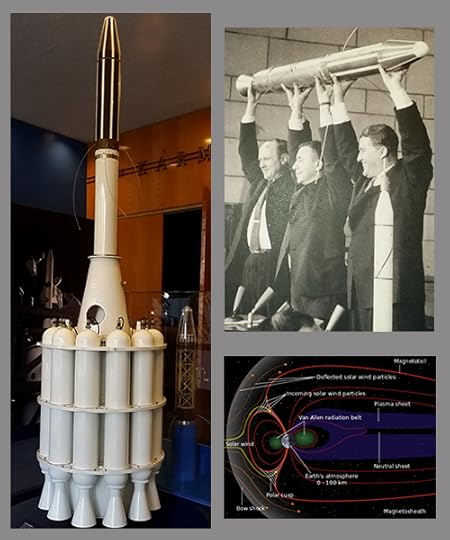 Left: Scale model of Explorer 1 satellite, including second stage rocket cluster. Right: William Hayward Pickering, James Van Allen, and Wernher von Braun display a full-scale model of Explorer 1 at a crowded news conference in Washington, DC after confirmation the satellite was in orbit (1958). Lower right: NASA depiction of the radiation belts surrounding the Earth.
Left: Scale model of Explorer 1 satellite, including second stage rocket cluster. Right: William Hayward Pickering, James Van Allen, and Wernher von Braun display a full-scale model of Explorer 1 at a crowded news conference in Washington, DC after confirmation the satellite was in orbit (1958). Lower right: NASA depiction of the radiation belts surrounding the Earth.
The tour group was led into an auditorium that included a full-scale model of Voyager I (although missing a long magnetometer boom), which made an appearance in the first Star Trek movie.
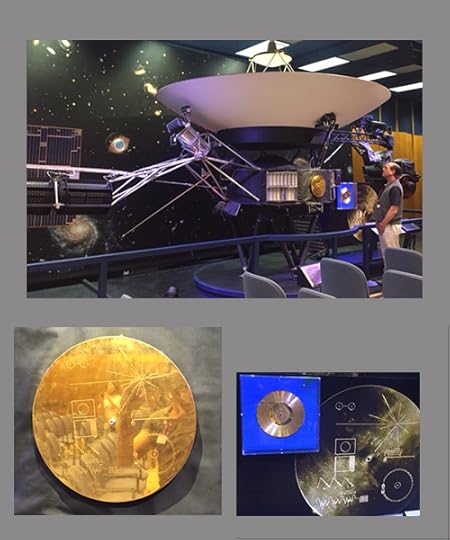 Top: Life-size replica of the Voyager spacecraft. Bottom left: Replica of the Golden Record’s cover. Bottom right: The Golden Record replica.
Top: Life-size replica of the Voyager spacecraft. Bottom left: Replica of the Golden Record’s cover. Bottom right: The Golden Record replica.
The other wing of the museum held scaled down replicas of many of the satellites, probes, and spacecraft responsible for major observations and discoveries over the past 30 years. One of my favorites, Mariner 10, flew by Venus before going into orbit around Mercury.
 Scaled down replica of the Mariner 10 probe.
Scaled down replica of the Mariner 10 probe.
The highlight of the museum visit for me was a moon rock collected during one of the Apollo missions. A piece of the moon–on Earth! 
 A moon rock collected and returned to Earth by NASA’s Apollo mission.
A moon rock collected and returned to Earth by NASA’s Apollo mission.
The tour brought us to a testing area where duplicates of the Mars rovers are tested. This is where they troubleshoot situations like broken wheels, sand pits, and other hazards that the rovers contend with.
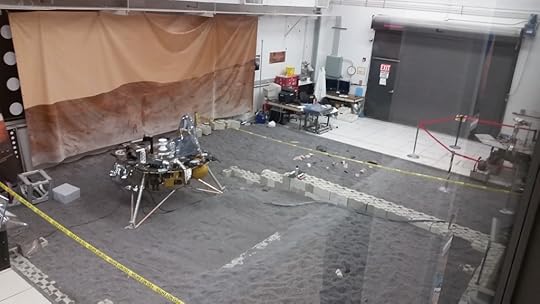 A testing ground for simulating conditions on Mars. (or maybe it’s where all the Mars landing footage is faked! j/k)
A testing ground for simulating conditions on Mars. (or maybe it’s where all the Mars landing footage is faked! j/k)
The most mind-blowing part of the tour was the visit to JPL’s Space Flight Operations Facility. From there, JPL controls the Deep Space Network, an international array of radio antennas that keep track of and communicate with active missions throughout the solar system. The Deep Space Network relies on antennas at Goldstone, near Barstow, California; near Madrid, Spain; and near Canberra, Australia. The spacecraft that send and receive information through the Deep Space Network include:
Voyagers 1 and 2, both of which are so far from the sun that we’re starting to get data of interstellar conditions for the first time
New Horizons, the probe that recently swung past Pluto and is relaying data that have completely reshaped our view of the planet
Mars Reconnaissance Orbiter, which relays signals to probes and rovers on Mars
Dawn, the first spacecraft to use an ion-drive for propulsion, is visiting the largest asteroids in between Jupiter and Mars, including Ceres and Vestas
 Mission Control at JPL’s Space Flight Operations Facility
Mission Control at JPL’s Space Flight Operations Facility
Live streams of data poured through JPL’s networks and we got to see a glimpse of it.
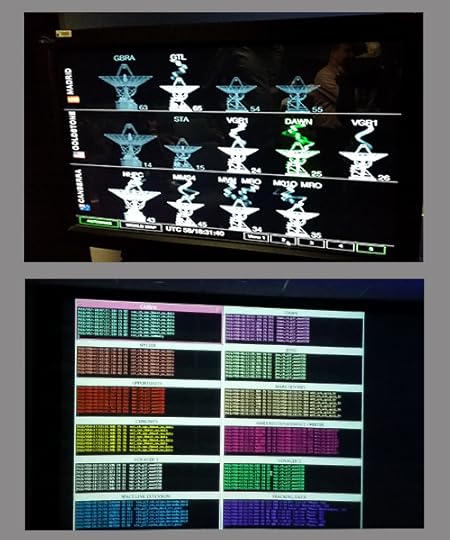 Top: A representation of the status of each antenna in the Deep Space Network and its connection to spacecraft throughout the solar system. Bottom: A live data feed from each active spacecraft.
Top: A representation of the status of each antenna in the Deep Space Network and its connection to spacecraft throughout the solar system. Bottom: A live data feed from each active spacecraft.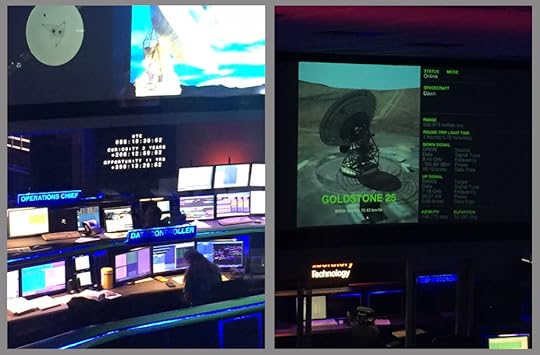 Left: Mission control, including mission clocks for two Martian rovers at center. Right: Depiction of one of the Goldstone 25 antenna’s connection to the Dawn spacecraft.
Left: Mission control, including mission clocks for two Martian rovers at center. Right: Depiction of one of the Goldstone 25 antenna’s connection to the Dawn spacecraft.
I hope to visit JPL again, and I highly recommend it to anyone in the Los Angeles/Pasadena area. Tours can be booked here. Or you can read all about JPL on their nicely designed website.
Next up: a summary of JPL’s ongoing missions and what they mean for astronomy, planetary science, and cosmology.
February 18, 2016
Finally Falling in Love with Neal Stephenson’s Anathem
I first heard of Neal Stephenson when one of the beta readers of a very early draft of Broken Mirror told me it reminded him of Snow Crash, a cyberpunk novel first published in 1992.
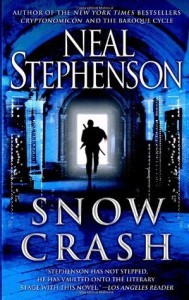 Snow Crash by Neal Stephenson
Snow Crash by Neal StephensonWhen I got around to reading Snow Crash, I was floored (in a good way). So many humorous descriptions of overtly branded and soul-sucked exurbia combined with a shockingly forethoughtful cyberscape to hook me right away. Adding in a sword-toting protagonist named Hiro Protagonist and a skateboard-riding teen femme fatale–Really, I need to stop here in case you haven’t read the book: Go read it now! Classic, entertaining cyberpunk. Not to be missed.
For those who have read Snow Crash or his other books, you understand how Neal’s books get under your skin with interesting action at the surface and kilometers of deep, science-based philosophizing underneath. He’s every bit an Arthur C. Clarke “hard sci-fi” devotee plus he brings the action and humor of Robert Heinlein and Douglas Adams combined, respectively. As you can tell, I’m a fan of Neal’s work.
So when I started to read Anathem and then felt compelled to put it down for being too dense, I didn’t know what to think. Was I literally not a smart enough nor devoted enough fan to appreciate this book? Had Neal written this book with so narrow an audience in mind that he hadn’t meant for me to read it? Was it (or was I) a lost cause?
Over the course of last year, I picked up the book two more times and stopped, despairing that I would ever finish. The made-up terminology was off-putting. I couldn’t tell what was at stake. The characters didn’t really seem all that distinct and would stop the story so they could argue some seemingly irrelevant philosophical point.
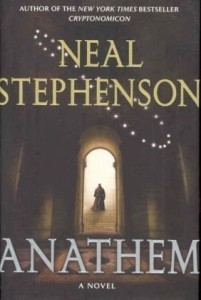 Anathem by Neal Stephenson
Anathem by Neal StephensonA few weeks after Broken Mirror was published, I picked up Anathem again.
I hit the same speedbumps while reading as before, but I was determined to power through.
Then something happened, either in my brain or in the story or somehow both quasi-entangled events happened around the same time. It was pure magic.
My conversion happened like this: One of the characters notices something in the sky, which he is not supposed to see because his ascetic “mathic order” (kind of like monks who do math) are supposed to focus solely on abstract “theorics” and are forbidden from using many technologies, including telescopes. And very quickly the whole world goes crazy and the story is off and running. We learn more about the world, we’re treated to semi-Socratic debates about the nature of reality and consciousness, and everything in the story becomes a treat. Neal’s spell is complete and we are enthralled by his words and his world.
Seriously, this is an author who makes reading dialogue about the multiverse and our place in it a treat.
I’m nearing the end of the book. I hope it doesn’t come too soon. I have a lot more on my reading list, but I suspect I’m going to be tempted to re-read Anathem with a newfound understanding of the majesty that Neal has written. Five stars.
February 13, 2016
A greeting from the 2016 San Francisco Writers Conference
January 28, 2016
A Fun Night to Celebrate Broken Mirror
Over three years ago, I started outlining and writing a science fiction series following Victor Eastmore’s adventures on Resonant Earth. Last week the first installment, Broken Mirror, a whopping 450+ page alternate history cyberpunk novel, was released in both ebook and paperbook formats.
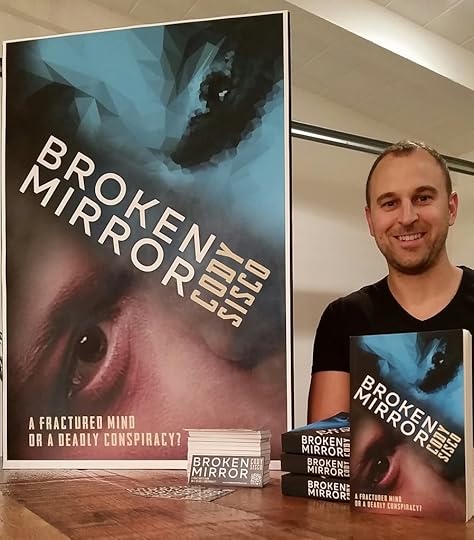 Here I am with my poster, proof copies, and bookmarks the night before the book launch party.
Here I am with my poster, proof copies, and bookmarks the night before the book launch party.On January 22, 2016, my friends, family, and writer colleagues attended a launch party at Covell Wine Bar in Los Angeles, California to celebrate. We entered through a secret bookcase door, drank beer from a tap in the brick wall, and enjoyed wines from around the world.
Most of all, I was glad my husband and parents came and enjoyed themselves.
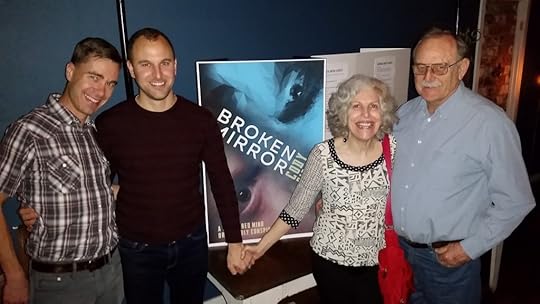 The Sisco family celebrates.
The Sisco family celebrates.Throughout the night, I ran several contests to give away unique signed proof copies. One of the winners (below, right) is a member of the Northeast Los Angeles Writers Group, which I help organize. Another is a local teacher (below, left).
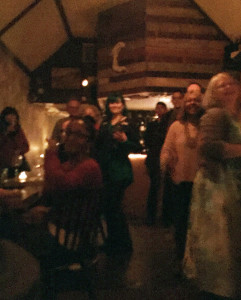 Members of the NELA Writers Group. Kibby (in front) won the first proof copy of Broken Mirror, a collector’s item!
Members of the NELA Writers Group. Kibby (in front) won the first proof copy of Broken Mirror, a collector’s item!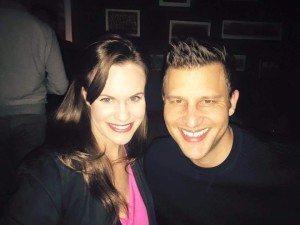 Happy people at the Broken Mirror Book Launch. Kara, at left, won a copy for creating the most engagement on social media.
Happy people at the Broken Mirror Book Launch. Kara, at left, won a copy for creating the most engagement on social media.
It was a wonderful and fun night. Thanks to everyone who attended.
January 18, 2016
My contribution to diversity in speculative fiction
Today is Martin Luther King Jr. Day in the United States. The media over the past couple years has increased the profile of inequities in the criminal justice system in how minorities are treated, which is a long-standing problem and a disgrace. The inequities are buried deep; we learn about them at an early age. Look at the lack of Oscar nominations for people of color. Kids are raised on media that doesn’t reflect the world around them. It leaves me scratching my head and wondering, Where are we now with race relations in the U.S.?
I grew up in a liberal, multi-ethnic community in California and went to public school. I was taught and internalized the values of non-discrimination, respect, equality, tolerance and justice. In a way, I was brought up to be race-blind.
As I grew older, of course, I came to realize that racism was alive and well, but it always seemed to be somewhere else. As a white kid, it didn’t affect me, but that didn’t stop me from seeing it and feeling let down that the “utopian” ideals I’d been brought up with were as illusory as Santa Claus. The sad truth is that I benefit from white privilege and ask myself what I can do about it.
As a writer, I try to create characters and worlds that showcase the shortcomings of society and how characters struggle to assert themselves in opposition to injustice. But I also get to create worlds that don’t have some of the problems ours does. In my book, Broken Mirror, which comes out this Friday, Reconstruction after the Civil War resulted in reparations for slavery, full equality for all minority groups, and a changed culture that embraced the notion that “skin is skin.” Victor, the main character, comes from a mixed-race family who can trace their ancestry back to both emancipated and slave-owning families. There are other important, diverse characters as well: a Latina woman, a Native American, a black hacktivist.
I say all this because I think it’s important to speak up about what I believe and what has influenced my writing. Maybe there’s a young person out there who will read this book and for a moment get to experience a world without racism.
(Disclaimer: the world of Broken Mirror is not free of discrimination. Much of the story takes place in Semiautonomous California where people with mental illnesses and Asian immigrants both face discrimination and injustice.)
December 7, 2015
Broken Mirror Release Date: January 22, 2016
I’m very pleased to announce that my first novel, Broken Mirror, will be published on January 22, 2016.
After three-plus years of writing and editing, Broken Mirror is coming soon to retailers. The book will be available in both paperback and ebook versions.
Note: At this point, I can pretty much guarantee that the ebook version will be available from Amazon, Apple Store, Barnes and Noble and other e-tail sites by Jan. 22. The print version release on that date is also likely, but there’s a slight chance that the book will be released several weeks after that. I’m working with my cover designer and printer to minimize any possible delay. Stay tuned for more details.
August 26, 2015
Inspiration and The Lucky Strike
I’m making one final editing pass for Broken Mirror before sending the manuscript to my beta readers. The focus will be on deepening characterization, cleaning up any plot holes introduced during the previous edit, and proofreading for typos, punctuation mistakes, etc.

Before diving in, however, I’m looking for inspiration to help me get into the right mindset. I want to re-imagine how Victor Eastmore’s mental disorder manifests itself and how I can convey that through language. I want readers to share in his experience, to come away from the book feeling like they’ve gained an understanding of how he perceives the world and his place in it.
I’ve written before about my inspiration for writing the Broken Mirror series. Now I want to share how I look for inspiration when editing.
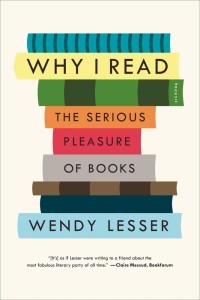 Why I Read by Wendy Lesser
Why I Read by Wendy LesserI received a hard copy of Wendy Lesser’s “Why I Read” as a gift at least one year ago, but I held off reading it, mainly because it seemed like one of those books that needs the right moment to have an impact. I was right; reading her wide-ranging thoughts on literature has giving me many ideas for revising the manuscript. Last night, as I read her insights on Henry James, Dostoyevsky, and Asimov, several things occurred to me:
The strength of any book relies mainly on the memorability of its characters and how they solve the problems inherent in the premise. For Broken Mirror, this means I need to strengthen passages that describe how Victor manages his mental disorder (through herbalism, behavioral therapy, and brainhacking, for example). But it’s not enough to include these passages. They have to seem important (emotionally) as well as pivotal to the progression of the plot. I now have a better idea where I’ll focus my editing energy and my approach to those sections of the book.
Language at the line level, i.e. the vocabulary, grammar, and cadence of individual sentences, must feel persuasive and cohesive throughout the entire novel. This is an important point to remember as I’m facing literally hundreds of pages and may be tempted to rush through, thinking, “Oh, that’s good enough,” or “I’m the only one who knows what’s wrong with that bit of dialogue.” No, every sentence is important, or it gets cut.
There are many very sophisticated readers out there, and I hope they will enjoy my book, that they’ll think it’s meaty, complex, and innovative enough for them to appreciate as a literary work. At the same time, there are many readers looking to be entertained by a mainstreamish, cyberpunk, alternate reality, detective sci-fi epic. These are not mutually exclusive audiences–my goal is to appeal to both, which means I must write and edit at multiple levels, using every technique I have at my disposal, and some that I haven’t quite mastered yet. So I’ll pay attention to the language, but I need to remember just to tell a good story.
After finishing Why I Read, I wanted to read ALL THE BOOKS, especially those that Wendy’s descriptions brought to life. However, I got into a bit of a funk by trying to fall in love with the wrong authors.
Based on an io9 list of science fiction and fantasy classics, Dahlgren by Samuel Delany had come to reside on my Kindle, and I had come to believe it was an important book for me to read. A few months ago, I read the first chapter in a bit of a stunned daze, (Could this actually be the final, edited, published version and not some rough, hastily composed early draft?). After the first chapter, I put the book down, both figuratively and literally, and didn’t come back to it.
But last night, seeking inspiration, I thought, I’ll give Dahlgren another try, all the way to the end, so that its literary majesty can soak into my brain and improve my writing. I made it to Chapter 4. There was no character, no plot, no feeling to hook me–the book was all shiny surfaces and writerly flourishes and it failed on a basic level to engage me. Perhaps if I approached it as an extended prose poem… No, I would only be fooling myself. Despite the appeal of setting and erotica, there were too many broken and misshapen images, too much tortured grammar, too many hideously generic lines of dialogue. Dahlgren may be a deliberate metafictional tour-de-force that Delany meticulously crafted, but it wasn’t for me. China Miéville writes using similarly lush, complex language and, perhaps, includes even more provocative settings with a better (though not outstanding) grasp of narrative drive. Anyway, I stopped reading, feeling guilty until I read the 1-star reviews at Goodreads and was reassured that many saavy readers had similar feelings and were able to express them far more eloquently their distaste.
But my book-reading fail-streak continued. I tried starting Robert Jordan’s Wheel of Time series and The Sword of Shannara by Terry Brooks, but they didn’t hook me right away–I plan to return to both when my patience is rejuvenated.
Then I picked up a slim volume containing a few of Kim Stanley Robinson’s short stories. To my utter dismay, after I started reading “The Lucky Strike,” two pages in, I didn’t seem to be interested. This is an author who I’ve followed very closely since discovering Red Mars when it was published and waiting patiently for years for the sequels, Green Mars and Blue Mars.
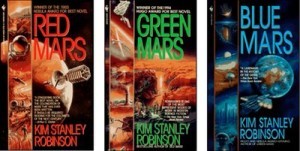 (credit: Bantam Spectra)
(credit: Bantam Spectra)His more recent works also continue to impress me, and I’m waiting to read his most recent, Aurora, for when I need a really good book. It was, therefore, shocking that “The Lucky Strike” didn’t appeal. (Note: I much prefer longer fiction over short stories, but I’m reasonably certain that I wouldn’t have been able to tell the length of “The Lucky Strike” by reading the first few pages, and I don’t think it influenced my initial opinion.)
I went to sleep disappointed. This morning, I gave “The Lucky Strike another shot.” I made it to page 26, settling into the story this time, certain I would make it to the end. And then I encountered several lines that impressed me so much, that created such useful openings into my editing process, that I had to stop reading and share them with you.
A little bit of setup (and spoilery!) is required.
 Captain Tibbets waving to press before the Hiroshima bombing run
Captain Tibbets waving to press before the Hiroshima bombing runIn this alternate history story, the Enola Gay (the Boeing B-29 Superfortress bomber responsible for the horror of Hiroshima), crashes on a training run, killing the pilot and crew. As a result, the story’s protagonist, Captain January, is slotted to drop the bomb using another bomber, the Lucky Strike, to fulfill the Enola Gay‘s mission. We become keenly aware of Captain January’s anxiety when he’s shown what kind of payload he’s dropping–he and the rest of the crew watch a film of the Trinity test explosion’s atomic fireball blossoming in the desert. Interesting setup, right?
Here are the lines that caught my attention:
For months now he [January] had been sure he would never fly a strike. The dislike Tibbets and he had exchanged in their looks (January was acutely aware of looks) had been real and strong.
…
Back on Tinian the lieutenant colonel congratulated them and shook each of their hands. January smiled with the rest, palms cool, heart steady. It was as if his body were a shell, something he could manipulate from without, like a bombsight.
…
With a rush of smoke out of him January realized how painfully easy it was to fool someone if you wanted to. All action was no more than a mask that could be perfectly manipulated from somewhere else.
First, I love how January’s sensitivity to the opinions of others is given physical form in the line, “January was acutely aware of looks.” And then it continues, “January smiled with the rest” [emphasis mine, here we see January aware that other people are smiling], and how easy it is, he thinks, to fool people. But we are not fooled. We know how much he is bothered about the bomb he must drop on Hiroshima. The difference between what he feels, what he shows to others, and what he will do about it is the hook.
Second, Robinson–Isn’t it strange how I feel I have to refer to Wendy Lesser by her first name because her book felt so intimate that I can’t imagine calling her “Lesser;” yet I can’t call my favorite author, “Kim,” even though I know his writing well?–anyway, Robinson uses metaphorical language that seems so effortless, so exactly on point that I had to put the book down and just breathe. January becomes his role. He becomes the bombsight. He reassures himself that action is just manipulation from without, even if “without” represents his conscious mind. The effect of this language is paradoxical. He becomes the thing that bothers him–the bomb–while at the same time distancing himself from the act–he can be “manipulated from somewhere else.” It sounds easy, uncomplicated, and the right frame of mind for distancing himself in advance from the atrocity that he is about to commit. This is genius because it creates tension at exactly the crux of the story: he is about to drop a bomb on Hiroshima and feels bad about it, but cares too much what other people think to raise any objection! So he says, “Yes, sir,” to his commander, he says, “Don’t worry about me,” to the military psychiatrist, and it appears as if he will indeed drop the bomb. And we’ll keep reading to find out if he does.
I’m now going to finish the story, and thanks to Robinson’s clever, emotionally rich writing, I won’t be able to stop until I reach the end.
August 11, 2015
Brainhacking – a new frontier?
[image error]Portrait of Elisabetha Drum (b. Scherer) of Kittsee, Austria by Michael StröckDo you ever feel mentally sluggish? As the years roll by, do you feel that you’re not staying at the top of your game? Do you wish you could return to the bright, sharp mind you used to have?
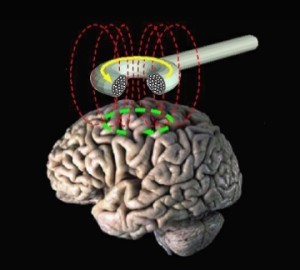 Transcranial Magnetic Brain Stimulation
Transcranial Magnetic Brain StimulationWe’re getting closer to the age of brainhacking, i.e. using tech to change what our minds are capable of. Our emotions, our habits, and our perceptions are going to be altered in ways we can’t imagine, if we can afford the enhancements.
The U.S. Academies’s Institute of Medicine recently conducted a workshop on Non-Invasive Neuromodulation of the Central Nervous System, i.e. brainhacking. The topics covered by the workshop included technologies for brainhacking, challenges and opportunities in proving their effectiveness and bringing them to market, and the social, ethical, and legal issues that are likely to arise.
A report on the workshop is available from the National Academies Press (the free, digital pre-publication draft report is linked). The most interesting findings from the workshop, in my view, include:
We know very little about the brain, how it works when it’s healthy, and how disease changes the way it functions. Much more research and knowledge is needed to be able to evaluate how and whether brainhacking improves patients’ lives.
These are the conditions for which brainhacking has been researched/indicated:
Psychiatric conditions
Depression, especially treatment-resistant depression (this is the most well developed use, but evidence for its effectiveness is low)
Post-traumatic stress disorder
Obsessive-compulsive disorder
Aggression
Addiction
Neurologic conditions
Epilepsy
Migraine
Movement disorders
Neuropathic pain
Tinnitus
Neurorehabilitation
The two main brainhacking technologies are electromagnetic and ultrasound. Electromagnetic includes electroconvulsive therapy (which has been around, and controversial, for a while) as well as different kinds of transcranial electric and magnetic stimulation.
Technical specifications include the shape and placement of coils on the head (gear), temporal characteristics and patterning of pulse sequences (zap), number and spacing of sessions (regime), combination with other therapies including medication.
Social, Legal and Ethical issues include:
non-physical harm to patients sense of “self” — just one among many possible negative effects
blurred lines between treatment and enhancement
the difficulty of ensuring safety and efficacy of over-the-counter and do-it-yourself treatments
There are many unresolved commercial issues including a regulatory approval pathway and challenges for reimbursement.
Although the future of brainhacking is uncertain, here are my fun but certain-to-be inaccurate predictions for the top five brainhacking applications:
1. Modulate your mood
 Transcranial Magnetic Brain Stimulation
Transcranial Magnetic Brain StimulationTranscranial magnetic brain stimulation is approved in the United States for treatment-resistant depression and a few other conditions. It’s thought that electromagnetic pulses created by magnets help make stronger connections between areas of the brain involved in mood regulation.
Our understanding of the underlying process is incomplete, for now. As our knowledge of the brain advances and we’re able to target micro-structures and modulate the magnetic fields involved, someday we could all make a quick trip to the brain clinic for a mood boost whenever we need it.
2. Get help with…damn, I forgot what I was about to say… (Clue: Memory)
[image error]The limbic system, especially the hippocampus, is associated with memory.
Image source: Blausen.com staff. “Blausen gallery 2014”. Wikiversity Journal of Medicine. DOI:10.15347/wjm/2014.010. ISSN 20018762. (Own work) [CC BY 3.0], via Wikimedia Commons There are many things you can do to improve and maintain your memory as you age. According to the Mayo Clinic, the Department of Health and Human Services recommends “at least 150 minutes a week of moderate aerobic activity (think brisk walking) or 75 minutes a week of vigorous aerobic activity (such as jogging) — preferably spread throughout the week.”
The folks over at Harvard Medical School recommend cognitive training regimes that focus on an individual’s specific goals, strengths and weaknesses. Reading and crossword puzzles seem to help, and a new batch of applications are aiming to improve our memory as well.
One thing is certain: use it or lose it.
3. Drop bad habits and addictions
You’re craving a cigarette. ZAP! That was your brain implant weaning you from your addiction with a light electromagnetic stimulus. It could happen.
Imagine a twelve step program where step one is a trip to the implant store and steps two through twelve are just getting on with your life, completely free from addiction. In other words, no more recovery group meetings. What will you do for fun now?
4. Induce a spiritual experience
![Finding the universal through meditation. [Source: Geralt, Pixabay.]](https://i.gr-assets.com/images/S/compressed.photo.goodreads.com/hostedimages/1455844075i/18158680._SX540_.jpg) Finding the universal through meditation. Source: Geralt, Pixabay.Drugs have long been used to open up the doors of perception and go walking amongst the divine. With brainhacking equipment, we can fine-tune the parts of the brain associated with orienting ourselves in space and time and emotional experience–sending us into instant nirvana where we feel the blissful interconnectedness of the universe, without years of meditation and practice. Serenity now, indeed.
Finding the universal through meditation. Source: Geralt, Pixabay.Drugs have long been used to open up the doors of perception and go walking amongst the divine. With brainhacking equipment, we can fine-tune the parts of the brain associated with orienting ourselves in space and time and emotional experience–sending us into instant nirvana where we feel the blissful interconnectedness of the universe, without years of meditation and practice. Serenity now, indeed.
5. Enhance your cognitive performance
![Mavericks Surf Contest 2010. By Shalom Jacobovitz (Own work) [CC BY-SA 3.0], via Wikimedia Commons](https://i.gr-assets.com/images/S/compressed.photo.goodreads.com/hostedimages/1455844075i/18158681._SX540_.jpg) By Shalom Jacobovitz (Own work) [CC BY-SA 3.0], via Wikimedia CommonsSometimes we need a little boost. In extreme sports, many top athletes seek the experience of flow, when time seems to slow down and thinking speeds up, to help them survive a deadly wave or to out-ski an avalanche. The enhanced state of mind associated with flow could come in handy in a lot of day-to-day jobs as well.
By Shalom Jacobovitz (Own work) [CC BY-SA 3.0], via Wikimedia CommonsSometimes we need a little boost. In extreme sports, many top athletes seek the experience of flow, when time seems to slow down and thinking speeds up, to help them survive a deadly wave or to out-ski an avalanche. The enhanced state of mind associated with flow could come in handy in a lot of day-to-day jobs as well.
Happy hacking!




